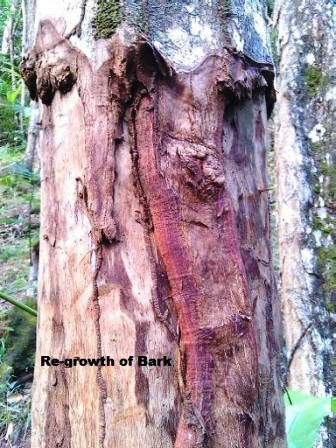Control methods reapplied to introduced trees
Over the past few months, the invasive species team on Praslin continued to tackle the introduced plant species in the Vallée de Mai and have been rigorously checking the trees that were previously controlled, re-applying or adapting the control methods where necessary.
Previously they had applied several different control methods to a range of introduced species where ring-barking was used for Lagati, Santol, Kalis Dipap, Kannel, Bwa Zonn and jackfruit trees. Strawberry Guava, Bwa Ber, the Rubber Tree and other introduced palms were controlled by having holes drilled in the stems and herbicide applied. For the coco plum plants, the team cut back the branches and sprayed herbicide onto the cut main stems. Vya Tang was manually pulled from the ground and dried on racks to prevent it from re-sprouting. The Filodendron creepers were also manually removed by cutting the base of the stem, pulling the creepers down and drying them on racks too.
Despite this initial treatment, all of the introduced trees need regular checks to assess their rate of deterioration. During these checks the team observed that some of the trees that were only ring-barked initially were showing signs of defence responses, such as bark re-growth, re-sprouting and aerial roots.
In order to prevent them from recovering, it was decided that the trees should be controlled using another method. They were still in good health and holes drilled into the trunks or stems into which herbicide was applied, were then sealed. These trees will continue to be monitored and it is hoped that this new method will be more effective.
Work on the Yellow Crazy Ants has also continued and the team have been doing experimental trials to remove them. They set up artificial nests made out of bamboo in certain areas around the Vallée de Mai. They will then monitor whether the ants have colonised these artificial nests, and if they have done then it could enable the team to remove the population of ants from the Vallée de Mai.
 |